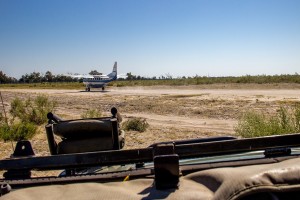
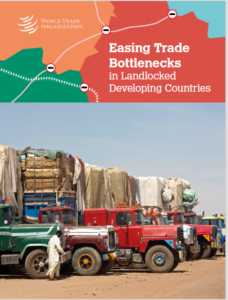 Geneva: Even as world trade recovered towards the end of 2020, Landlocked Developing Countries (LLDCs) exports continued to decline by as much as 8 per cent, while global exports grew by 7 per cent, according to a new World Trade Organization (WTO) publication launched on December 8, 2021, highlights the high trade costs faced by LLDCs due to their isolation from the world’s largest markets.
Geneva: Even as world trade recovered towards the end of 2020, Landlocked Developing Countries (LLDCs) exports continued to decline by as much as 8 per cent, while global exports grew by 7 per cent, according to a new World Trade Organization (WTO) publication launched on December 8, 2021, highlights the high trade costs faced by LLDCs due to their isolation from the world’s largest markets.
The study finds that LLDCs’ trade costs are 1.4 times higher than those of developing countries with a coastline. It also details LLDCs’ vulnerability to climate change but notes the benefits that trade in services and e-commerce can bring to these countries.
Higher trade costs for businesses in LLDCs result from the many challenges they face in trying to integrate into global supply chains, and the COVID-19 pandemic has magnified those challenges across a number of areas.
LLDCs are mostly commodity exporters. The export of commodities itself is not the main economic development hindrance for LLDCs, as other developing countries primarily export commodities as well.
However, LLDCs exports are not as competitive due to higher transport costs. According to the United Nations Office of the High Representative for the Least Developed Countries, Landlocked Developing Countries and Small Island Developing States (UN-OHRLLS), LLDCs on average pay more than double in transport costs than transit countries and experience longer times to send and receive merchandise from overseas markets. These high transport costs discourage investors, impede economic growth and limit the capacity of LLDCs to achieve sustainable development.
Also read:
- How Uzbekistan’s farmers overcome soil salinity and water shortages
- COVID-19 pandemic poses unforeseen challenges to the multilateral trading system
Since LLDCs rely solely on transit countries for their external trade, they are subject to the quality of transport infrastructure, transit laws (i.e. insurance, licensing) and bureaucracy of their neighbours, who often are themselves developing countries.
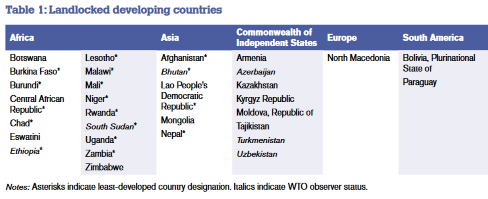
The main trade bottlenecks identified (including examples), both at the border and within LLDCs, commonly include
the following (Also see Figure 1):
- a lack of coordination in the development and maintenance of transport infrastructure (e.g. inefficient border infrastructure);
- a lack of standardization and harmonization (e.g. transloading from and between different modes of freight);
- a lack of border coordination and cooperation between customs and other border agencies and traders (e.g. unwarranted long waiting times at customs);
- burdensome documentary requirements and paper processing of documentation (e.g. multiple clearances and
declarations at customs); - a lack of human and financial resources (e.g. shortage of skilled staff to promote better understanding of the TFA);
- a lack of equipment and digital infrastructures (e.g. information communications technology (ICT) and laboratory equipment for the implementation of the TFA).
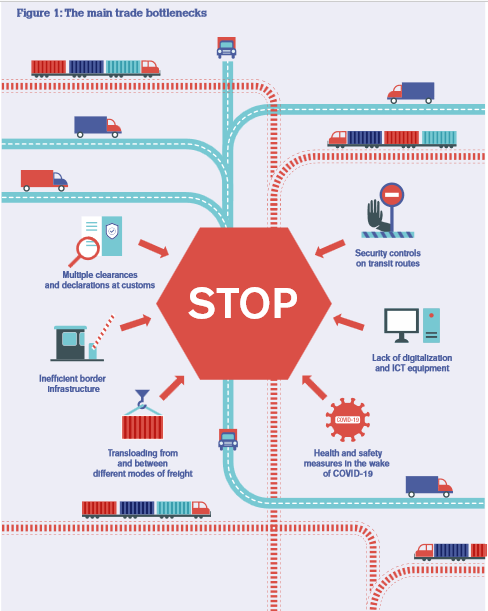
LLDCs, including least-developed countries (LDCs) that are landlocked, highlighted how the pandemic magnified the existing challenges they face arising from a great digital divide among and within countries. A large portion of their businesses have not digitalized and have had to close during the pandemic. Only a few domestic online business operators concentrated in major cities have been able to run their business smoothly due to insufficient health protective measures and disruption in domestic transportation and supply systems. Many businesses are located far from the border, so without a fully integrated domestic business structure (including an ICT system), it is not possible for the domestic supply chain to be fully operational and linked with cross-border trade. Besides, border closures because of lockdowns to curb the spread of pandemic often have unintended effects on trade bottlenecks, since many border closures also apply to traders and maritime, road and rail transport workers.
This trend in LLDC trade highlights the importance of implementing the WTO’s Trade Facilitation Agreement (TFA) in LLDCs to simplify, modernize and harmonize export and import processes.
Freedom of transit has always been part of the international trade architecture. Article V of the General Agreement on Tariffs and Trade (GATT) 1994 and Article 11 of the TFA makes provision to facilitate the freedom of transit for goods between WTO members. Although the freedom of transit provisions help to establish guidelines to facilitate
LLDC trade, they are insufficient and would benefit from recognition of the special needs of LLDCs.
In her opening remarks, WTO Director-General Ngozi Okonjo-Iweala reiterated her commitment to promoting a more inclusive multilateral trading system: “LLDCs face particularly acute versions of realities that all members must grapple with, as complex emerging challenges, such as climate change, threaten development possibilities and future prosperity. We must leverage the potential of trade to meet these challenges. … We must also ensure that the gains from trade are equally distributed. Enhancing integration into regional and global value chains of women, youth and small businesses creates jobs and opportunities, and helps reduce inequality … In a world marked by the COVID pandemic, the paths that lead to economic growth cannot be separated from those that lead to inclusion.”
– global bihari bureau




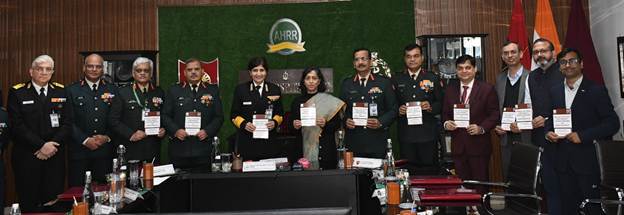

Wow, fantastic blog layout! How long have you been blogging for? you make blogging look easy. The overall look of your site is magnificent, as well as the content!
Stunning quest there. What occurred after? Good luck!
We are a group of volunteers and opening a new scheme in our community. Your website offered us with valuable information to work on. You’ve done an impressive job and our whole community will be grateful to you.
Throughout this great pattern of things you receive a B+ with regard to effort. Where exactly you actually confused me personally was first in the particulars. As it is said, the devil is in the details… And that couldn’t be much more true at this point. Having said that, let me reveal to you exactly what did give good results. The writing is definitely highly powerful and this is probably the reason why I am making an effort in order to opine. I do not really make it a regular habit of doing that. Next, while I can certainly see a leaps in logic you come up with, I am not necessarily certain of how you appear to unite the details which in turn produce the final result. For right now I shall subscribe to your issue but trust in the foreseeable future you actually connect your facts much better.
This is the fitting blog for anybody who needs to seek out out about this topic. You understand a lot its almost laborious to argue with you (not that I really would want?HaHa). You definitely put a brand new spin on a topic thats been written about for years. Great stuff, simply nice!
Hi, Neat post. There is an issue together with your site in internet explorer, could check this? IE still is the market chief and a huge part of folks will miss your wonderful writing due to this problem.
Thanks for your post. One other thing is that individual states have their particular laws in which affect house owners, which makes it very hard for the the legislature to come up with a new set of guidelines concerning foreclosure on homeowners. The problem is that each state offers own legal guidelines which may have impact in an unfavorable manner in terms of foreclosure insurance plans.
Thanks for the guidelines you have shared here. Another thing I would like to state is that laptop or computer memory demands generally go up along with other innovations in the technology. For instance, when new generations of processors are made in the market, there is usually a corresponding increase in the type preferences of both the computer system memory and also hard drive room. This is because the software program operated simply by these cpus will inevitably boost in power to take advantage of the new technologies.
F*ckin? remarkable things here. I am very happy to see your article. Thank you so much and i’m looking forward to touch you. Will you kindly drop me a mail?
Thanks for your intriguing article. One other problem is that mesothelioma cancer is generally brought on by the breathing of dust from asbestos fiber, which is a carcinogenic material. It is commonly witnessed among laborers in the engineering industry who have long experience of asbestos. It can also be caused by living in asbestos covered buildings for an extended time of time, Genes plays an important role, and some individuals are more vulnerable towards the risk as compared with others.
I do enjoy the way you have presented this particular challenge and it does indeed give me personally some fodder for consideration. Nonetheless, from what precisely I have personally seen, I basically trust when other reviews pile on that people today remain on point and in no way start upon a tirade involving the news of the day. Anyway, thank you for this fantastic point and even though I can not necessarily go along with this in totality, I regard the viewpoint.
Throughout this great scheme of things you actually get an A for hard work. Exactly where you lost everybody was first in your particulars. You know, they say, details make or break the argument.. And that couldn’t be more true here. Having said that, allow me inform you just what did do the job. The authoring is definitely quite convincing and that is most likely why I am making the effort in order to comment. I do not really make it a regular habit of doing that. 2nd, despite the fact that I can certainly see the jumps in reason you come up with, I am definitely not sure of just how you seem to unite the details which inturn produce your conclusion. For now I shall yield to your position but trust in the foreseeable future you link your facts much better.
One more issue is really that video gaming has become one of the all-time largest forms of fun for people of every age group. Kids enjoy video games, and adults do, too. The particular XBox 360 is just about the favorite games systems for many who love to have hundreds of games available to them, and who like to relax and play live with some others all over the world. Thank you for sharing your ideas.
There are some attention-grabbing time limits on this article however I don?t know if I see all of them middle to heart. There is some validity however I will take hold opinion until I look into it further. Good article , thanks and we wish more! Added to FeedBurner as nicely
I truly appreciate this post. I have been looking everywhere for this! Thank goodness I found it on Bing. You’ve made my day! Thanks again
Good site! I really love how it is easy on my eyes and the data are well written. I am wondering how I could be notified whenever a new post has been made. I have subscribed to your feed which must do the trick! Have a nice day!
Nice post. I learn something new and challenging on blogs I stumbleupon every day. It will always be useful to read articles from other writers and use a little something from other websites.
Thanks for the sensible critique. Me & my neighbor were just preparing to do a little research on this. We got a grab a book from our local library but I think I learned more from this post. I am very glad to see such excellent information being shared freely out there.
The information shared is of top quality which has to get appreciated at all levels. Well done…
Great web site you have got here.. It’s difficult to find high quality writing like yours nowadays. I really appreciate people like you! Take care!!
This web site really has all of the info I wanted about this subject and didn’t know who to ask.
Hi, I do believe this is an excellent website. I stumbledupon it 😉 I may return yet again since i have bookmarked it. Money and freedom is the greatest way to change, may you be rich and continue to help other people.
Thank you a lot for sharing this with all of us you actually recognize what you’re talking approximately! Bookmarked.
Excellent website. A lot of useful info here. I am sending it to several pals and also sharing in delicious. And certainly, thank you in your effort!
Great article. It is very unfortunate that over the last one decade, the travel industry has already been able to to fight terrorism, SARS, tsunamis, bird flu, swine flu, along with the first ever real global economic downturn. Through all this the industry has proven to be strong, resilient as well as dynamic, locating new approaches to deal with hardship. There are generally fresh complications and the possiblility to which the sector must all over again adapt and react.
Thank you, I have recently been searching for info approximately this topic for a while and yours is the best I’ve found out so far.
Valuable information. Lucky me I found your website by accident, and I’m shocked why this accident didn’t happened earlier! I bookmarked it.
This is the very first time I frequented your website page and thus far I am surprised with the research you made to create this particular publish extraordinary. Magnificent job!
The information shared is of top quality which has to get appreciated at all levels. Well done…
“Convenient travel wallets”
Hi there, I found your site by way of Google while searching for a comparable topic, your website came
up, it seems to be good. I have bookmarked it in my google bookmarks.
Hi there, simply become alert to your blog thru Google, and found that it is really informative.
I am going to watch out for brussels. I will appreciate for those
who continue this in future. Many other folks can be benefited from your writing.
Cheers!